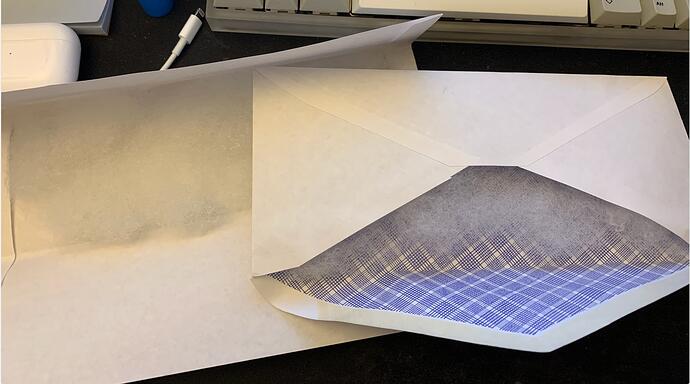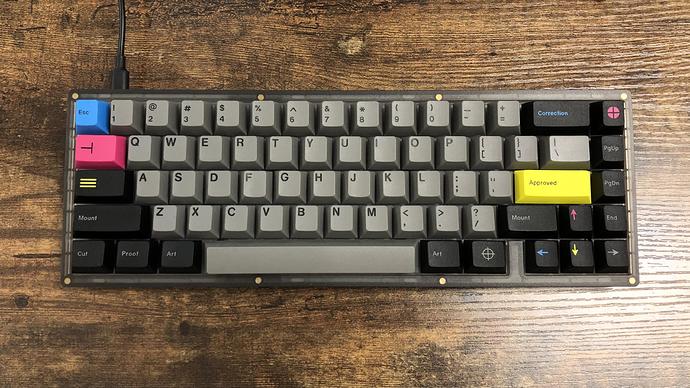You can eliminate a lot of the leaf noises if you lube the legs and the leaf-to-leaf contact area. I used to feel the same after becoming more of a tactile fan but now all my tactiles are lubed this way and I love them.
The idea of pre-forming Poly-fil worked out well.
I went with simplest method using just what was in arms reach:
- Stuffed some Poly-fil into a plain letter envelope.
- Placed the envelope under my 15-inch MBP, near the back where it gets toasty.
- Left it there until I needed it, a few days later.
There you go, a Toasted Poly-fil Padding Patty ready to be served. 
For some reason, that you used a MacBook Pro as a heat-press gave me a great chuckle.
It was within arms reach and was hot enough. lol
Left: handmade prototype version
Right: production version (off-the-shelf parts only so easy to scale)
Today I received Gateron CJ (waterproof) switches and you know what?
Better than I expected. I thought I was gonna be in a “Bird in the hand is worth two in the bush” situation but I’m happy that I am pleasantly surprised by how much I like these. Not in my top of all switches, but I can understand if I was new to the hobby, these would be an amazing switch straight out of the bag and probably even more amazing once lubed up.
I think it’ll be fun to throw these switches onto something soon 
How would you describe their sound? I know the top housing is the same material as Inks but I always found the sound of Inks to be a bit…ploppy for my tastes.
CJ should sound similar to Cream although not exactly.
POM housings’ bottom-out sound has an interesting high-pitched warble at the end that reminds me music genres like yodeling in Europe and trotte in Far East. There is also a trace of it with Bobba U4LT which made suspect they put a bit of POM into the housing.
A build combo I found that brings it out the most is tray-mount acrylic board with copper-lined FR4 plate. May be too faint to notice with gasket mount.
Have you tried the Oil King switches? To me they have a similar smoothness, but a better sound and spring.
Waterproof?
Is that the box version?
yeah
Not yet, but I’ve been meaning to at some point ![]()
I do have a few boards to build, but I already have a lot of switches ![]()
Hopefully in the near future I’ll find a suitable project to get those switches for
I hear ya. I have far too many switches. I’m not sure if the better solution is to sell some, or buy more boards 
I don’t think it’s ip certified like Kailh since they don’t share any internal specifications.
Anyway, if u like them u will probably like the Ink Box to.
Hotswap is the way. I have 3 or 4 keebs I actually use, two that I use regularly - but I’ve collected more than a hundred full sets of switches. (If you do decide to sell some, though, I’m pretty much always looking to expand that collection.)
One of those daily keebs has a different set of switches in it almost every week. Most times I’m putting something new into it over the weekend - but sometimes I return to solid favorites just to enjoy them.
Part of me wants to build a keeb for every set of switches I own… the other part of me has a mortgage. ![]()
Better yet, having a fleet of hotswap boards to maximize modding pleasure. And having two identical hotswap boards makes effect of a mod is easier to tell.
Pretty much my endgame state.
Can confirm, aforementioned fleet of hotswaps is mostly KBD67Ls.
Yup. I think we have the same idea about what true endgame looks like.
A delicious dilemma of sort that comes up with such setup is when one of the boards ascends into godly perfection. Question is do you continue tinkering with it to, somehow, make it even better or leave it as is.
My Cream board was just that. I opted to leave it as is. Had too many instances where restoring a board to last known good state didn’t feel the same.
Aye. I’ve just run into that recently myself not long ago; one of my 67L’s has reached its “final form” aside maybe from messing around with the stab tuning. The configuration is just right for my intended use-case, so I don’t plan on changing it.
I’d been using mostly linears in this board for quite a while - *nixdork Boba LTs, then TTC Aces for a month or so - but I ended up going with a silent tactile. I’ve settled on TTC Silent Bluish Whites for this one, but only after removing the silicone weight I’d previously installed. They felt too harsh and I was ready to put in the Frozen Silent linears, but decided to try the SBWs without the weight…
This is another reason for multiple of the same model; so there’s still a comparison / tester platform around when one of them “graduates” - ha!
I think a lot of the switches I own are pure fomo, but they were still purchased in the pursuit of the perfect experience of that switch type. What it has lead to, with linears anyhow, is drastic diminishing returns. Honestly, even if I found that perfect switch, I wouldn’t want every board populated with them (variety being the spice of life and all that).
I appreciate hotswap, and have budget-leaning boards like the bakeneko in which I have no problem using as a tester for new experiences. But I don’t like to put wear on the sockets of more expensive boards (or frankly the switch legs/leaves) so they don’t get used for switch rotation. I view the hotswap utility on those boards, say the U80-A, as an easier way to “rebuild” the board if I really hate the set-up or have to replace the stabs, instead of having to bust the desoldering gun out.
Also, a hotswap configuration is a bit limiting for different plate and PCB experiences. It’s not ideal for say, a half plate, flex cut PCB set-up, or a plateless build with a gasket mounted PCB like the Thera. Then there is the issue with many boards only offering a soldered PCB option altogether.
I think the best solution to my very first world problem, is to consolidate my switches, and in turn my boards, into the most premium and unique experiences for my tastes. But that seems like a lot of work that I won’t do, lol. Know thyself, amiright.
Yes, definitely!
Topical coffee ramble:
While most of my boards have sockets at this point, I only rotate switches frequently in the one I think of as a tester - and I picked that one specifically because it’s easy to take apart quickly.
Most of the rest I don’t think of as “hot-swap” so much as “solder-free” - customs for sure, but also some of the middle market ones. Not just for longevity, but because of some feature(s) that would discourage frequent use of the sockets;
-
Plastic case threads that will wear much faster than the sockets (pre-revision NK65EE)
-
A tight plate that will chew up switches (pre-revision NK65EE, TES68)
-
An expensive or hard to replace PCB (Grid 650, Ikki68)
-
No easy / non-destructive way to disassemble and support the sockets from below while installing switches (Mojo68)
-
Stock plate with fairly loose grip that can easily wear and become more loose (KBD67L R1)
On one hand, the 67L is an ideal tester on paper because replacement PCBs are easy to find and aftermarket plates are, too - but the assembly process takes me 2-3 times as long than with the Portico because of the recessed torx screws, and aftermarket plates being held by the switches.
Meanwhile the Portico has 5 basic screws and a stock FR4 plate with an almost just-right amount of grip on the switches. The negative to using it as a tester is that over time the plate will wear a bit and not grip switches as well, especially if you pull a bunch out without fully releasing the clips - and there’s not nearly as much aftermarket support as with the KBD67s. Still - for me, that particular board hits the sweet spot of quality and convenience to be a great switch testing platform.
Once I find a switch that works well with the rest, I tend to leave them in place.


